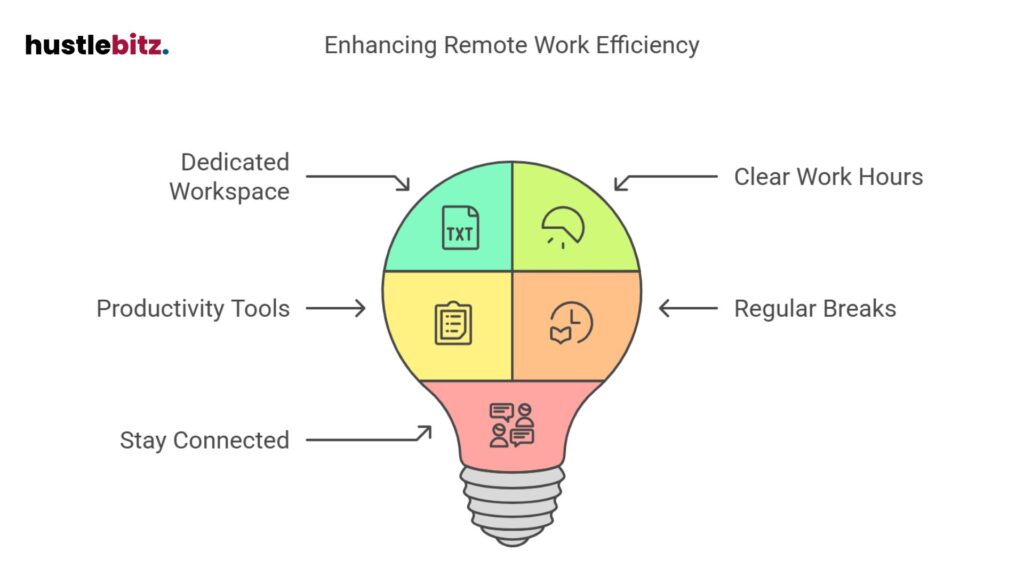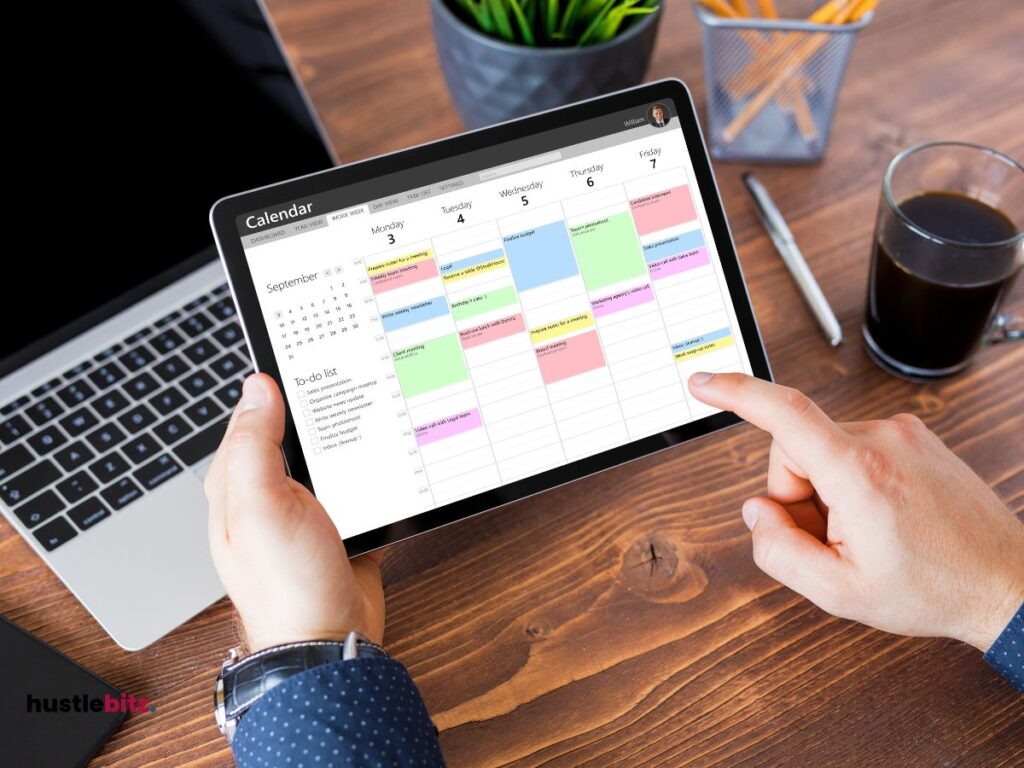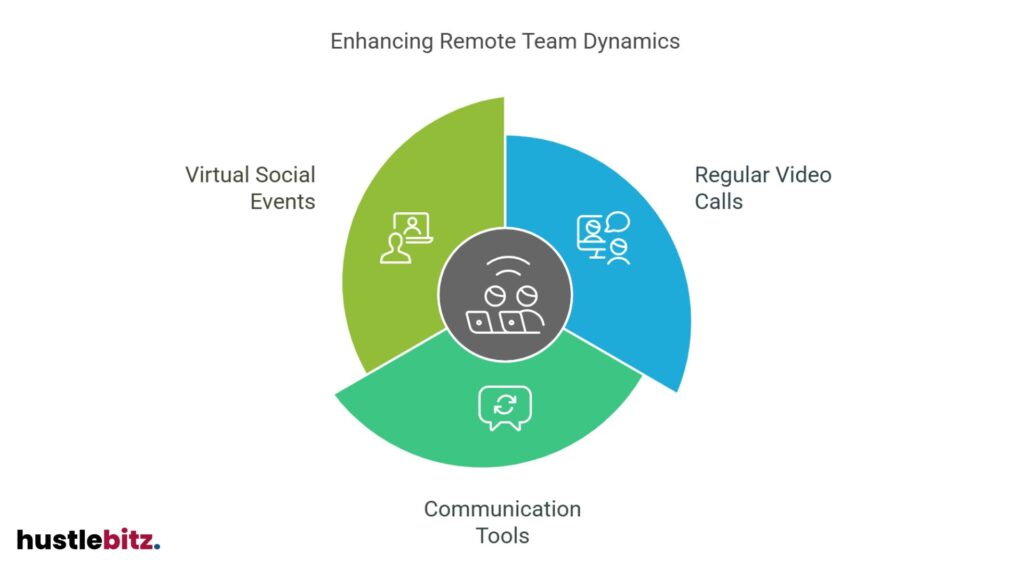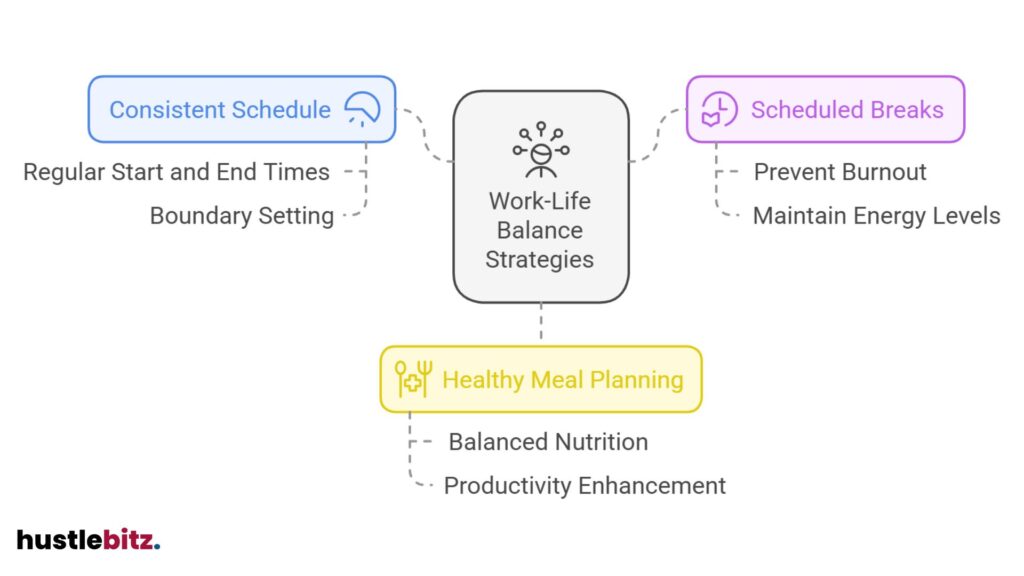Increasing productivity during remote work involves several effective strategies. First, establish a dedicated workspace to minimize distractions. Set clear work hours to create structure and accountability. Utilize productivity tools for task management and collaboration. Prioritize daily tasks using methods like the Eisenhower Matrix. Limit distractions by creating boundaries and employing strategies like the Pomodoro Technique. Maintain regular communication with colleagues to enhance teamwork. Prioritize time management and maintaining a healthy routine to support energy levels. Lastly, reflect on your strategies regularly to identify areas for improvement. These practices can significantly enhance your remote work experience and boost productivity.
Key Takeaways
- Establish a dedicated workspace to minimize distractions and enhance focus during remote work.
- Set clear work hours to create structure and foster accountability in your routine.
- Utilize productivity tools for effective task management, collaboration, and time tracking.
- Take regular breaks to recharge mentally and physically, preventing burnout and maintaining performance.
- Stay connected with colleagues through video calls and communication tools to promote teamwork and reduce isolation.

1. Establish a Dedicated Workspace
Creating a dedicated workspace is essential for enhancing focus and minimizing distractions in a remote work environment. A well-defined area for work fosters an atmosphere conducive to productivity, allowing individuals to separate their professional responsibilities from personal life. This separation is crucial for maintaining a healthy work-life balance, as it helps individuals mentally transition into work mode, thereby boosting productivity.
When establishing a dedicated workspace, consider factors such as location, ergonomics, and resources. Choose a spot in your home that is quiet and away from common distractions, like television or household chores. Invest in ergonomic furniture, as this not only promotes comfort but also encourages longer, more productive work sessions. Additionally, ensure that your workspace is equipped with the necessary tools, such as a reliable computer, high-speed internet, and adequate lighting, all of which contribute to remote work productivity.
Furthermore, personalizing your workspace can enhance motivation and creativity. Incorporate elements that inspire you, whether through decor, plants, or motivational quotes. These small touches can significantly impact your ability to stay focused and engaged in your tasks.
2. Set Clear Work Hours

Establishing a dedicated workspace lays the groundwork for setting clear work hours, which is vital for maintaining a structured and productive remote work routine. In a work-from-home environment, the absence of traditional office boundaries can blur the lines between personal and professional time. By defining specific work hours, individuals can create a framework that enhances focus and minimizes distractions.
Setting clear work hours not only helps in managing time effectively but also fosters accountability. When employees adhere to a defined schedule, they are more likely to remain disciplined and motivated. This structure encourages a routine that can lead to increased productivity, allowing individuals to allocate specific time blocks for various tasks and projects.
Moreover, establishing these hours enables better communication with colleagues and supervisors. When everyone is aware of one another’s availability, it facilitates collaboration and reduces the chances of misunderstandings. Additionally, a consistent schedule can contribute to improved work-life balance, as it allows individuals to designate time for personal activities without the intrusion of work responsibilities.
To maximize the benefits of remote work, it is crucial to prioritize time management. By setting clear work hours, individuals can create a sense of normalcy and routine that is often lacking in a remote setting. Ultimately, adopting this practice can significantly enhance one’s ability to focus, meet deadlines, and achieve professional goals, contributing to overall success in the remote work landscape.
3. Use Productivity Tools

Utilizing productivity tools can significantly enhance efficiency and organization in a remote work environment, enabling individuals to streamline their tasks and manage their time more effectively. By integrating various productivity tools into your daily routine, you can optimize your workflow and create a more structured workday.
Project management software is particularly valuable for remote teams, offering features that help track progress, assign tasks, and set deadlines. These tools not only provide clarity on project timelines but also foster accountability among team members.
Additionally, utilizing collaboration tools such as video conferencing and instant messaging platforms allows teams to stay connected, facilitating real-time communication and reducing feelings of isolation that can occur in remote work settings.
Moreover, productivity tools often include features like time tracking and reporting, which can help you identify areas for improvement and adjust your strategies accordingly. By analyzing your productivity patterns, you can make informed decisions that directly impact your efficiency.
Incorporating these tools into your remote work strategy can significantly boost your productivity, allowing you to focus on high-priority tasks while minimizing distractions. Establishing a routine that leverages these technologies will not only enhance your individual performance but also contribute to a more cohesive team dynamic.
Ultimately, embracing productivity tools is a crucial step toward achieving success in a remote work environment, ensuring that you remain organized, engaged, and connected with your colleagues.
4. Prioritize Daily Tasks
Effective prioritization of daily tasks is essential for maintaining focus and maximizing productivity in a remote work setting. With the shift to a work-from-home environment, members of the remote workforce often face unique challenges that can hinder their efficiency. By implementing clear prioritization strategies, individuals can improve productivity and achieve their goals more effectively.
To start, it is crucial to distinguish between urgent and important tasks. A well-structured to-do list can serve as a powerful tool in this process. Begin each day by identifying the top three tasks that need immediate attention. This not only helps to streamline efforts but also provides a sense of accomplishment as these tasks are completed.
Additionally, adopting the Eisenhower Matrix can aid in categorizing tasks based on their urgency and importance, allowing you to focus on what truly matters. This method encourages workers to stay motivated by providing clarity on what should be addressed first.
Another effective strategy is to allocate specific time blocks for different tasks throughout the day. This method, often referred to as time blocking, can help maintain momentum and prevent burnout. By setting aside dedicated periods for focused work, individuals can enhance their overall productivity.
5. Limit Distractions

Minimizing distractions is a crucial factor in enhancing productivity while working remotely, as it allows individuals to maintain focus and achieve their objectives efficiently.
In a remote work environment, distractions can manifest in various forms, from household chores and social media notifications to family interruptions. Identifying and mitigating these distractions is essential for maintaining a productive workflow during work hours.
To limit distractions effectively, one should create a designated workspace that is separate from common areas of the home. This physical boundary helps signal to oneself—and others—that it is time to focus on work.
Additionally, utilizing tools such as noise-canceling headphones can help drown out ambient sounds, further promoting concentration.
Setting specific work hours is also beneficial. By establishing clear boundaries around when one is available for work and when one is not, it becomes easier to communicate with family members or housemates about minimizing interruptions.
Utilizing techniques such as the Pomodoro Technique, which involves working in focused bursts followed by short breaks, can also help in managing distractions while ensuring that one stays productive throughout the day.
6. Take Regular Breaks

Incorporating regular breaks into the remote work routine is essential for sustaining high levels of productivity and preventing burnout. While the flexibility of a remote workplace can enhance employee productivity, it also poses the risk of extended work hours without sufficient rest. Taking breaks is crucial for maintaining productivity, as it allows employees to recharge both mentally and physically.
Research indicates that short breaks can improve focus and concentration. By stepping away from screens, employees can return to their tasks with renewed energy and clarity. These breaks can be as simple as a five-minute walk, stretching, or engaging in a brief mindfulness exercise. Such activities not only refresh the mind but also reduce the likelihood of fatigue, which can hinder overall performance.
Moreover, establishing a structured break schedule can help in creating a balanced work-life environment. It encourages individuals who work remotely to delineate their work hours, fostering a sense of routine that may be lacking in a home office setting. This structure can help prevent the blurring of boundaries between work and personal time, ultimately promoting a healthier work-life balance.
7. Stay Connected With Colleagues

Maintaining strong connections with colleagues is vital for fostering collaboration and enhancing productivity in a remote work environment. The feelings of isolation that can accompany remote work often hinder effective communication, making it essential to implement strategies that encourage teamwork and connection among remote team members.
Here are some effective ways to stay connected:
- Regular Video Calls: Schedule consistent video meetings to discuss ongoing projects and team goals. These face-to-face interactions promote engagement and help mitigate feelings of isolation, allowing team members to connect on a personal level.
- Utilize Communication Tools: Leverage platforms like Slack or Microsoft Teams to facilitate ongoing conversations and collaboration. These tools enable quick exchanges of ideas, updates, and feedback, ensuring that communication remains fluid and effective.
- Virtual Social Events: Organize informal gatherings, such as virtual coffee breaks or team-building activities. These events provide an opportunity for team members to socialize, share experiences, and build rapport, which ultimately strengthens the team’s cohesion.

8. Practice Time Management

Effective communication and strong connections with colleagues can only thrive when individuals manage their time wisely, allowing for a balanced approach to remote work responsibilities.
Time management is crucial for remote workers who often navigate the blurred lines between professional and personal life. By prioritizing tasks and setting clear deadlines, remote workers can enhance their productivity while working from home.
To practice effective time management, remote workers should consider utilizing tools like digital calendars, task management software, and time-tracking applications. These tools can help in organizing daily tasks, setting reminders, and monitoring progress, thereby fostering a structured work environment.
Implementing techniques such as the Pomodoro Technique—where work is divided into intervals, typically 25 minutes, followed by short breaks—can also significantly aid in maintaining focus and preventing burnout.
Moreover, establishing a routine helps remote workers allocate specific times for focused work, meetings, and breaks. This not only enhances productivity but also ensures that work-life balance is maintained.
9. Maintain a Healthy Routine

Establishing a healthy routine is essential for remote workers to sustain their productivity and well-being in a home environment. A structured day can help mitigate the distractions that often accompany remote work, allowing individuals to work without compromising their effectiveness. By maintaining a healthy routine, remote workers can optimize their workday and enhance their overall performance.
Here are three key elements to consider when developing a healthy routine:
- Consistent Start and End Times: Even with flexible work hours, aim to establish a regular schedule. This consistency helps to create a clear boundary between work and personal time, enabling you to focus during work hours and unwind afterward.
- Scheduled Breaks: Integrating short breaks throughout your workday is crucial. Taking regular breaks can prevent burnout and maintain your energy levels. Aim for a 5-10 minute break every hour to stretch, hydrate, or engage in a brief mindfulness exercise.
- Healthy Meal Planning: Nutrition plays a significant role in maintaining energy and focus. Plan your meals ahead of time to ensure you’re eating balanced, nutritious foods that will keep you alert and productive during your work hours.

10. Reflect and Adjust Strategies

Regularly reflecting on and adjusting strategies is vital for remote workers to enhance their productivity and adapt to changing circumstances. In the unique landscape of remote work, employees often face distinct challenges that can impact their productivity levels. This necessitates a proactive approach where remote employees may take time to evaluate their current practices and identify areas for improvement.
To effectively reflect and adjust strategies, remote workers should first assess their daily routines and workflows. This involves examining what tasks are being accomplished efficiently and which ones are hindering productivity. By tracking their performance, remote employees can discern patterns that either contribute to or detract from their overall effectiveness.
Additionally, it is essential to solicit feedback from team members. Open communication fosters a supportive work culture and allows for the sharing of best practices. This collaboration can lead to the development of new strategies that not only optimize individual productivity but also enhance the team’s collective output.
Moreover, flexibility is key in a remote environment. As circumstances evolve—be it changes in project demands, technology, or personal responsibilities—adjusting strategies accordingly helps employees remain engaged and focused. By embracing a mindset of continuous improvement, remote workers can ensure they are equipped to tackle challenges head-on and maintain high productivity levels.
Ultimately, reflecting and adjusting strategies is a critical component of thriving in a remote work setting.
Final Thoughts
Increasing productivity during remote work requires a strategic approach that combines effective time management, clear communication, and the creation of a conducive work environment. By establishing dedicated workspaces, setting clear work hours, and leveraging productivity tools, remote workers can maintain focus and efficiency. Additionally, prioritizing tasks, taking regular breaks, and staying connected with colleagues are essential practices that enhance productivity. Finally, reflecting on and adjusting strategies ensures continuous improvement and adaptability in a remote work setting. By consistently applying these techniques, remote workers can achieve a balanced and productive work life, leading to sustained success in their professional endeavors.




